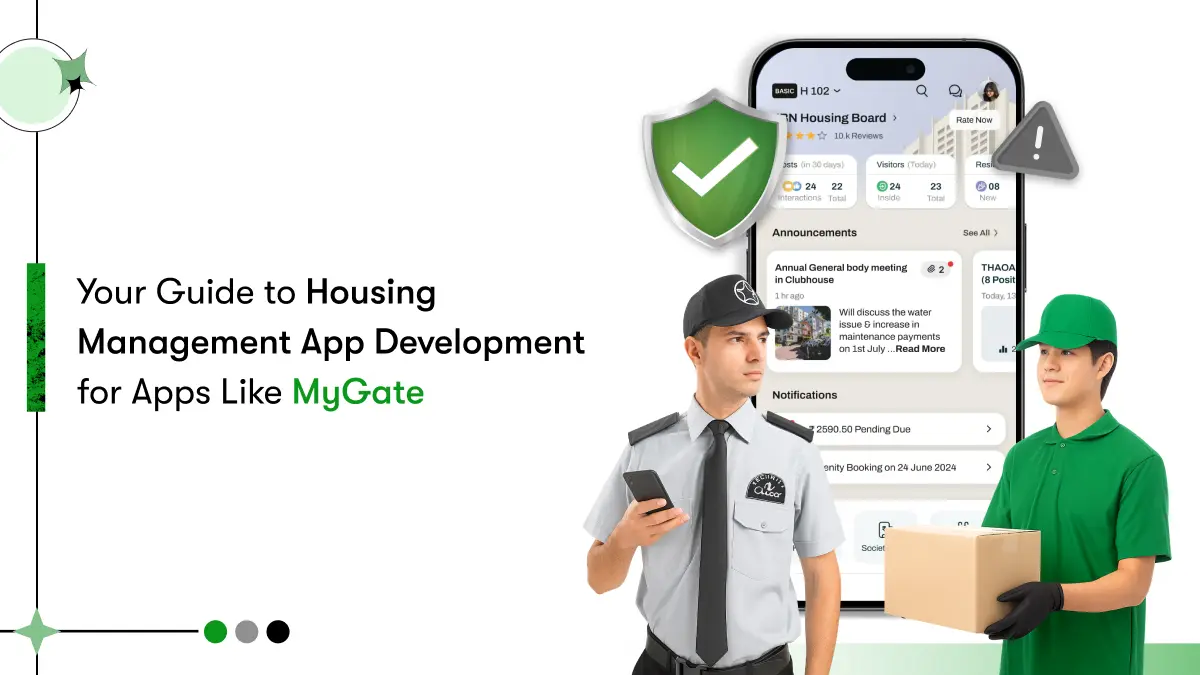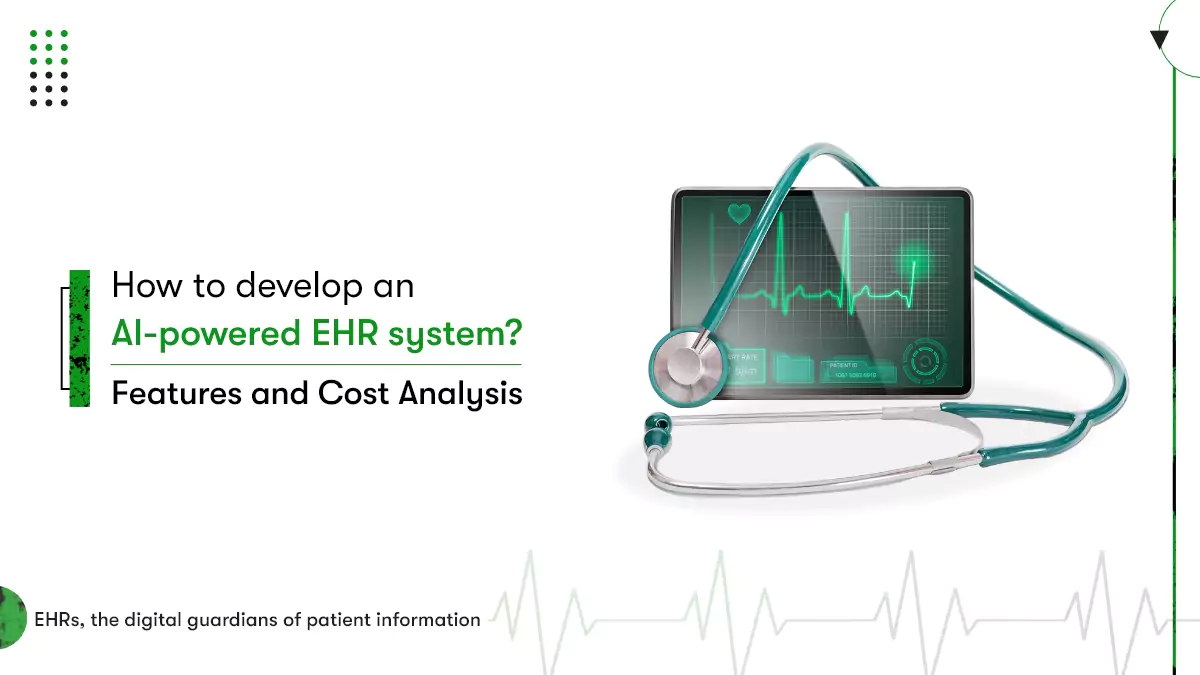Housing management app development helps communities run smoothly without the daily headaches of manual work. Picture a housing society where visitor details are lost in paper registers, fee reminders vanish in chat groups, and residents keep calling for updates. It is stressful for everyone.
Now picture a housing community management app that records visitors instantly, sends automated payment alerts, and lets residents log requests in seconds. This is already becoming a preferred choice for many housing boards and property managers.
The global smart home security market was valued at USD 33.94 billion in 2024 and is set to reach USD 82.07 billion by 2030, growing at 15.2 percent CAGR. Much of this growth comes from housing societies and residential complexes adopting advanced management systems, driving demand for housing management app development.
If you want to build an app like MyGate, you are entering a market with strong demand and plenty of room for new players.
In this guide, you will learn the key features, process, and cost to develop an app like MyGate.
MyGate Success Story and What It Teaches About Housing Management App Development
When MyGate launched in 2016, housing management apps were still rare. Fast forward:
- $10M funding from Prime Venture Partners
- 60M+ users and 2.5M homes served
- Presence in 11 major cities
Its growth shows that with the right features, business model, and timing, a housing community management app can dominate its market quickly.
Today, MyGate serves around 60 million users and 2.5 million homes, making it one of the most trusted names in gated community management. With just a tap, residents can manage visitor entries, streamline security, and communicate with their housing society.
MyGate’s rapid growth shows how quickly communities are adopting smarter ways to live and work together. As more developing cities look to join its network, MyGate’s model offers a clear lesson: with the right features, strategy, and timing, housing management app development can turn a new idea into a market leader within a few years.
How Housing Management App Development Like MyGate Works End to End
Here is the practical flow your team will follow. It covers user journeys, frontend behavior, backend design, data, and ops. Also, the team of this application would have set clear goals during the Lean Canvassing and Prototyping because of which the outcome is so brilliant.
This section also helps anyone planning to develop an app like MyGate with a clear blueprint.

Core roles and apps
- Residents use iOS and Android apps.
- Guards use a simplified Android app with kiosk controls.
- Society admins use a secure web dashboard.
This setup supports housing community management app development at scale across many societies.
1) Onboarding and identity
Goal: verify people and map them to homes.
Flow:
- Admin adds towers, units, and resident lists in the dashboard.
- Residents sign up with phone number and OTP verification.
- System links each profile to a flat and role. Owners and tenants may have different rights.
- Guards receive device-bound logins to prevent unauthorized access.
Use rate limits and reCAPTCHA to reduce abuse during housing management app development.
Tech notes:
- Auth server issues short-lived JWTs with refresh tokens.
- Roles and permissions live in a policy store.
- PII stays encrypted at rest with field-level keys.
2) Visitor and delivery management
Goal: fast, secure gate entries without long queues.
Resident actions:
- Create a guest invite with name, phone, and visit window.
- Share a QR or a six‑digit code with the guest.
Guard actions:
- Scan QR or enter code.
- Capture a photo and vehicle details when required.
- Check watchlists and unit approvals.
System actions:
- Log entry, notify the resident, and start an active visit session.
- Auto-expire sessions at checkout or preset time.
Edge cases to handle: no phone guest, network outage, duplicate names, and shift change.
Queues on the device store scans offline and sync later. This reliability detail is vital when you build an app like MyGate.
Tech notes:
- QR generation on device, validation on server.
- Watchlist checks run through a low‑latency cache.
- Photos go to object storage with signed URLs.
3) Payments and accounting
Goal: collect society dues and reconcile without spreadsheets.
Flow:
- Admin defines fee rules per unit type and due dates.
- System raises invoices and sends reminders through push and SMS.
- Residents pay through UPI, cards, ACH, or bank transfers.
- Webhooks confirm success and trigger receipts.
- Reconciliation marks invoices as paid and updates ledgers.These steps support anyone who wants to develop a housing community management app with serious finance features.
Tech notes:
- Use idempotency keys for payment retries.
- Store only tokens from the payment provider.
- Support split settlements to the society account.
4) Service tickets and work orders
Goal: track issues to closure with clear ownership.
Flow:
- Residents files a ticket with category, photos, and priority.
- Admin triages and assigns to an internal team or vendor.
- SLA timers start and pause on status changes.
- Chat thread stores updates and photos.
- Closure needs a resident rating and comment.
This loop creates measurable outcomes during housing management app development.
Tech notes:
- Ticket states drive events over a message queue.
- Analytics service computes SLA breaches each day.
- Search service indexes tickets for instant filters.
5) Announcements and community feed
Goal: reduce noisy chat groups and missed notices.
Flow:
- Admin posts notices with attachments and optional acknowledgements.
- Residents get push alerts with deep links to the post.
- Polls collect quick opinions.
- Emergency posts override silent settings for everyone.
Healthy engagement here helps housing community management app development succeed with adoption.
Tech notes:
- Push through FCM and APNs with topic subscriptions.
- Store read receipts for audit trails.
- Throttle alerts to prevent notification fatigue.
6) Amenities, bookings, and penalties
Goal: fair access to gyms, pools, and clubhouses.
Flow:
- Admin defines assets, slots, and capacity rules.
- Residents book slots and pay if required.
- Guards validate QR passes at entry.
- No‑shows trigger automatic penalties.
Booking logic is a proven hook when you develop an app like MyGate.
Tech notes:
- Use optimistic locking to prevent double bookings.
- Calendar service maintains slot inventories.
- Refund logic handles cancellations and waitlists.
7) Security controls and patrols
Goal: improve trust without friction.
Features to include:
- Patrolling routes with GPS checkpoints.
- Panic button for residents with location sharing.
- Vehicle sticker or RFID registration.
- Contractor entry with time‑bound passes.
These controls show depth when stakeholders assess the cost to develop an app like MyGate.
Tech notes:
- Geofencing runs on-device for low battery impact.
- Location events stream to the backend for audits.
- Retain sensitive logs with strict access controls.
Frontend architecture in practice
- Mobile stack: Kotlin or Swift for native, or React Native or Flutter for shared code.
- Guard app: large buttons, offline queue, low‑light camera, and kiosk mode.
- Resident app: fast home screen, one‑tap actions, and local caching.
- Web dashboard: React or Vue with server pagination and export tools.
Accessibility and snappy navigation build trust as you build an app like MyGate.
Backend and data design
- API layer: REST for simplicity, GraphQL for flexible dashboards.
- Services: auth, users, units, visitors, payments, tickets, content, bookings, and notifications.
- Databases: relational for core records, document store for logs and forms.
- Caching: Redis for sessions, rate limits, and hot reads.
- Async layer: message queue for notifications and webhooks.
- Storage: S3‑compatible buckets for images and documents.
This modular setup supports reliable housing management app development across many tenants.
Key models to define clearly: Tenants, Towers, Units, Residents, Staff, Visitors, Vehicles, Devices, Tickets, Invoices, Payments, Amenities, Bookings, Posts, and Consents.
Security and privacy
- Encrypt data in transit with TLS and at rest with managed keys.
- Apply least‑privilege roles across apps and support device binding.
- Rotate secrets and log every admin action.
- Offer data export, retention settings, and consent capture.
These controls matter to boards that plan to develop a housing community management app responsibly.
DevOps, scaling, and reliability
- CI pipelines run tests, lint checks, and security scans on every merge.
- Blue‑green or canary releases reduce deployment risk.
- Autoscaling keeps check‑in queues short during rush hours.
- Centralized logs, metrics, and alerts support quick incident response.
- Nightly backups, restore drills, and regional redundancy guard against data loss.
Such discipline protects brand trust when you develop an app like MyGate for many cities.
Analytics and growth loop
- Cohort dashboards track activation, repeat bookings, and payment success.
- Funnel views show where residents drop off.
- A/B tests refine invites, reminders, and slot rules.
- Admin trends help boards plan staffing and budgets.
Clear insights often justify the cost to develop an app like MyGate within a single fiscal cycle.
You now have the moving parts and their handshakes. Pick the first release around visitor entry, payments, and tickets. Add bookings and advanced security in later sprints. This staged plan keeps risk low during housing management app development and speeds time to value.
How Does a Housing Community Management App Like MyGate Make Money?
If you plan to develop a housing community management app, understanding the business model is as important as the technology itself. MyGate uses a subscription-based pricing model where each society pays a monthly fee based on the number of homes.
For example, a society with 150 houses might pay around ₹3,000 per month for the service. This predictable revenue stream makes it easier to scale and forecast income.
In addition to subscriptions, MyGate has introduced in-app purchases. Residents can order household essentials, pet care products, and other daily needs directly from the app. These purchases generate additional revenue through commissions or partnerships.
Another revenue channel is utility bill payments. Users can recharge gas connections, pay electricity bills, and even top up their mobile accounts without leaving the app.
This combination of subscriptions, transactions, and partnerships not only offsets the mobile app development cost but also shows why housing management app development can be both profitable and sustainable when designed with multiple revenue streams in mind.

What Does Housing Society Management App Development Cost?
The cost of housing society management app development depends on your app’s complexity, features, and the team you hire. To create an app like MyGate, you’ll need developers, UI/UX designers, QA testers, and project managers working together.
On average, developing such an app can start from $30,000 and go higher depending on your requirements. However, the pricing may vary depending on the following cost-variation factors:
- Features and functionality
- UI/UX design complexity
- App maintenance and updates
- Security requirements
- Location of the app development company
- Chosen platform (iOS, Android, or both)
- Total development hours
- Hourly rates
Estimated Cost Breakdown for Housing Management App Development
| Region | Simple MVP (Core Features) | Full-Feature App (Like MyGate) | Hourly Rate Range |
| India | $18,000 – $25,000 | $35,000 – $50,000 | $25 – $50 |
| Eastern Europe | $25,000 – $35,000 | $50,000 – $70,000 | $35 – $65 |
| Western Europe | $35,000 – $50,000 | $70,000 – $95,000 | $50 – $90 |
| USA & Canada | $50,000 – $70,000 | $90,000 – $140,000 | $80 – $150 |
| Australia | $40,000 – $60,000 | $75,000 – $110,000 | $60 – $110 |
Tech Stack Impact on Cost:
- Native (Swift for iOS, Kotlin for Android) – Higher cost, best performance.
- Cross-platform (Flutter, React Native) – Lower cost, faster time-to-market.
If you plan to build an app like MyGate, starting with an MVP is the most cost-effective way. You can later expand with advanced features like in-app purchases, booking systems, and utility integrations as your user base grows.
Well, a word of suggestion: You can also connect with us or hire our mobile app developers for your excellent community management app development. Our creative heads would leave no stone unturned in delivering an app solution that surpasses your expectations.
Step-by-Step Process for Housing Management App Development
If you’re planning housing management app development, a clear roadmap makes the journey from idea to launch smoother and faster. Here’s the proven step-by-step process we follow to build reliable, scalable apps like MyGate.

Step 1: Discovery and Requirement Analysis
Meet stakeholders and capture real daily workflows across residents, guards, and admins. Map goals into measurable success metrics like faster check-ins or higher on-time payments. Turn problems into user stories and acceptance criteria. This foundation guides why you want to develop a housing community management app in the first place.
Step 2: Product Scope and Prioritization
List features, group them into must‑have, should‑have, and later. Define an MVP that proves value within one quarter. Tie every feature to a metric and a user story. This discipline keeps housing community management app development focused and on budget.
Step 3: UX and UI Design
Sketch resident, guard, and admin journeys, then turn them into clickable prototypes. Validate flows with five to seven real users from a society. Finalize accessible UI patterns, empty states, and error messages. Strong design reduces rework when you develop an app like MyGate.
Step 4: Backend Architecture and Data Design
Set up a secure, multi‑tenant backend with clear domains for visitors, payments, tickets, and bookings. Choose a relational database for core records and object storage for images and files. Add queues for webhooks and notifications to keep the app responsive. This structure powers reliable housing management app development at scale.
Step 5: Core Feature Development
Build visitor invites, gate check‑ins, and instant resident notifications first. Add payments for maintenance dues with webhooks, receipts, and clean reconciliation. Ship service tickets, announcements, and amenity bookings next. These features create daily value and help you build an app like MyGate that people actually use.
Step 6: Security, Quality, and Compliance
Protect data with strong authentication, role‑based access, and field‑level encryption. Write unit tests, API tests, and real device tests for the guard flow. Add audit logs, consent capture, and data export options. These steps reduce risk while you develop a housing community management app for regulated markets.
Step 7: Launch, Onboarding, and Training
Release the app to stores, then onboard one or two pilot societies. Train guards with a short video and a kiosk checklist. Offer admin quick‑start guides and a response plan for peak hours. A smooth rollout supports adoption and strengthens the case for the cost to develop an app like MyGate.
Step 8: Monitoring, Iteration, and Scaling
Track activation, check‑in speed, payment success, and ticket resolution time. Run A/B tests on reminders, booking limits, and guard prompts. Scale infrastructure with autoscaling and regular load tests, then expand to new societies. Continuous improvement keeps housing community management app development on a winning path.
A clear process removes uncertainty and keeps your project moving forward with confidence. Whether you are building a simple MVP or aiming for a feature-rich platform, following these steps will help you avoid costly mistakes and shorten your time to market.
We are an excellent mobile app development company that can help you develop an app in this niche. Our contact information lies right at the end of this blog. Do not hesitate to contact us if you have any questions.
What factors contribute to a mobile app development cost variation? Here is A Complete Guide On Cost Variation in Application Development.
Conclusion
If you have read this far, you already see the potential. Communities everywhere are looking for better ways to manage security, payments, and day-to-day operations. A well-planned housing management app can put your business at the center of that change and give you an advantage in a growing market.
The opportunity is here now. Each month, more companies enter this space, and the ones who move first often gain the largest share. You already have the idea. What you need is a team that can turn that idea into a solution people will use every day and recommend to others.
Kody Technolab has built apps that thousands of people rely on daily. Our team understands housing community management app development from start to finish, from designing smooth experiences for residents to creating reliable tools for security staff and administrators.
If you are ready to build an app like MyGate, click the link below, share your vision, and we will guide you through every step of making it a reality.













 Contact Information
Contact Information